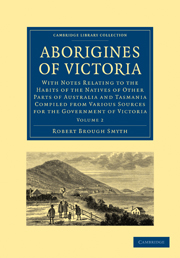 Aborigines of Victoria
Aborigines of Victoria Book contents
- Frontmatter
- Contents
- LIST OF ILLUSTRATIONS
- LANGUAGE
- APPENDICES
- A Notes and Anecdotes of the Aborigines of Australia, by Philip Chauncy, J.P., District Surveyor at Ballarat
- B Traditions of the Australian Aborigines on the Namoi, Barwan, and other Tributaries of the Darling, communicated by the Rev. William Ridley, M.A., &c.
- C Notes on the Natives of Australia, by Albert A. C. Le Souëf
- D Notes on the Aborigines of Cooper's Creek, by Alfred W. Howitt, F.G.S., P.M. and Warden, Bairnsdale
- E Notes relating to the Aborigines of Australia, by the late John Moore Davis
- F Notes on the System of Consanguinity and Kinship of the Brabrolong Tribe, North Gippsland, by A. W. Howitt, F.G.S., P.M. and Warden, Bairnsdale
- G Notes on the Language and Customs of the Tribe inhabiting the country known as Kotoopna, by William Locke
- H Hunting the Blacks, by the late A. F. A. Greeves
- I The Crania of the Natives, by Professor Halford, of the Melbourne University
- THE ABORIGINES OF TASMANIA
- INDEX
- Plate section
G - Notes on the Language and Customs of the Tribe inhabiting the country known as Kotoopna, by William Locke
Published online by Cambridge University Press: 05 August 2011
- Frontmatter
- Contents
- LIST OF ILLUSTRATIONS
- LANGUAGE
- APPENDICES
- A Notes and Anecdotes of the Aborigines of Australia, by Philip Chauncy, J.P., District Surveyor at Ballarat
- B Traditions of the Australian Aborigines on the Namoi, Barwan, and other Tributaries of the Darling, communicated by the Rev. William Ridley, M.A., &c.
- C Notes on the Natives of Australia, by Albert A. C. Le Souëf
- D Notes on the Aborigines of Cooper's Creek, by Alfred W. Howitt, F.G.S., P.M. and Warden, Bairnsdale
- E Notes relating to the Aborigines of Australia, by the late John Moore Davis
- F Notes on the System of Consanguinity and Kinship of the Brabrolong Tribe, North Gippsland, by A. W. Howitt, F.G.S., P.M. and Warden, Bairnsdale
- G Notes on the Language and Customs of the Tribe inhabiting the country known as Kotoopna, by William Locke
- H Hunting the Blacks, by the late A. F. A. Greeves
- I The Crania of the Natives, by Professor Halford, of the Melbourne University
- THE ABORIGINES OF TASMANIA
- INDEX
- Plate section
Summary
Campbellfield House, 5th December 1876.
Dear Sir,–The following is a corrected copy of a letter of mine which appeared in the Argus some years ago on the above subject. If it is of any use to you in the compilation of your book, I shall be pleased.
I am, dear Sir,
Yours faithfully,
WILLIAM LOCKE.
R. Brough Smyth, Esq.
When a very young man, I held a large tract of country, called in the native language Kotoopna (now wrongly spelled Kotupna), extending nearly across the angle formed by the Goulburn and Murray. This portion of country belonged to a small tribe of blacks called Pangorang, or Waningotbun. The men were very fine specimens of the Aboriginal, many of them being considerably upwards of six feet in stature, and exceedingly active and warlike in appearance. At that time they subsisted principally upon fish and wild-fowl, which they procured in great abundance on the Lower Moira. The ducks were caught wholesale in the following manner:–A large net was stretched across a narrow neck of a lagoon, when a blackfellow would go some distance up or down the creek, and drive or frighten the ducks towards the net, when numbers in their flight would be caught in the meshes. I have also seen them catch ducks by diving underneath them, and suddenly laying hold of them by the legs.
- Type
- Chapter
- Information
- Aborigines of VictoriaWith Notes Relating to the Habits of the Natives of Other Parts of Australia and Tasmania Compiled from Various Sources for the Government of Victoria, pp. 333 - 335Publisher: Cambridge University PressPrint publication year: 2010First published in: 1878
